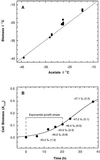Effects of acetate on facultative autotrophy in Chlamydomonas reinhardtii assessed by photosynthetic measurements and stable isotope analyses
- PMID: 10759539
- PMCID: PMC58978
- DOI: 10.1104/pp.122.4.1439
Effects of acetate on facultative autotrophy in Chlamydomonas reinhardtii assessed by photosynthetic measurements and stable isotope analyses
Abstract
The green alga Chlamydomonas reinhardtii can grow photoautotrophically utilizing CO(2), heterotrophically utilizing acetate, and mixotrophically utilizing both carbon sources. Growth of cells in increasing concentrations of acetate plus 5% CO(2) in liquid culture progressively reduced photosynthetic CO(2) fixation and net O(2) evolution without effects on respiration, photosystem II efficiency (as measured by chlorophyll fluorescence), or growth. Using the technique of on-line oxygen isotope ratio mass spectrometry, we found that mixotrophic growth in acetate is not associated with activation of the cyanide-insensitive alternative oxidase pathway. The fraction of carbon biomass resulting from photosynthesis, determined by stable carbon isotope ratio mass spectrometry, declined dramatically (about 50%) in cells grown in acetate with saturating light and CO(2). Under these conditions, photosynthetic CO(2) fixation and O(2) evolution were also reduced by about 50%. Some growth conditions (e.g. limiting light, high acetate, solid medium in air) virtually abolished photosynthetic carbon gain. These effects of acetate were exacerbated in mutants with slowed electron transfer through the D1 reaction center protein of photosystem II or impaired chloroplast protein synthesis. Therefore, in mixotrophically grown cells of C. reinhardtii, interpretations of the effects of environmental or genetic manipulations of photosynthesis are likely to be confounded by acetate in the medium.
Figures


References
-
- Bennoun P. Chlororespiration, sixteen years later. In: Rochaix J-D, Goldschmidt-Clermont M, Merchant S, editors. The Molecular Biology of Chloroplasts and Mitochondria in Chlamydomonas. Advances in Photosynthesis. Vol. 7. Dordrecht, The Netherlands: Kluwer Academic Publishers; 1998. pp. 675–683.
-
- Bulté L, Gans P, Rebéillé F, Wollman F-A. ATP control on state transitions in vivo in Chlamydomonas reinhardtii. Biochim Biophys Acta. 1990;1020:72–80.
-
- Chen F, Johns MR. Substrate inhibition of Chlamydomonas reinhardtii by acetate in heterotrophic culture. Proc Biochem. 1994;29:245–252.
Publication types
MeSH terms
Substances
LinkOut - more resources
Full Text Sources
Other Literature Sources

